CAPE CANAVERAL, Fla. — The moon doesn't get much bigger and brighter than this.
On Monday, Earthlings will be treated to a so-called supermoon. That's the closest full moon of the year, or every 14 months to be precise.
Monday's supermoon will be extra super — it will be the closest the moon comes to us in almost 69 years. And it won't happen again for another 18 years.


NASA says closest approach will occur at 6:21 a.m. EST when the moon comes within 221,523 miles (356,508 kilometers). That's from the center of the Earth to the center of the moon. Full moon will occur at 8:52 a.m. EST.
NASA planetary geologist Noah Petro is urging everyone to step outside and soak in the view. Prime viewing will be Sunday and Monday nights.
Want to get a picture of the Supermoon? Here’s tips from Bill Ingalls, NASA Photographer.
- Get something else in the shot for reference.
- Do your research, plan in advance where to shoot.
- The moon will be closest during Monday morning’s moonset, but Sunday evening will be great too.
- Taking the pic on a smartphone? Tap the screen and hold your finger on the moon to lock the focus. Then slide your finger up or down to darken or lighten the exposure.
- Using a digital SLR? Use the daylight white balance setting. If you use longer lens, remember the moon is a moving object. Balance between trying to get the right exposure and a faster shutter.
According to EarthSky.org, the moon will turn precisely full on November 14 at 1:52 p.m. UTC, or 8:52 a.m. ET.
For viewers in eastern North America and Europe, the best view will likely be on the night of November 13, or the following night.
Early risers on the US West Coast should be able to spot it near its fullest at 5:52 a.m. PST, as the sun does not rise in that region until 6:25 a.m.
Moon spotters in Asia are perhaps the best placed to catch the moon at its absolute largest, with full moon occurring at 9:52 p.m. Hong Kong time, or 7:22 p.m. in India.
While the moon will likely be visible throughout the day (depending on cloud coverage), supermoons are best viewed at night, away from sources of light pollution.
Some information from CNN is included in this story.
If you want your photos or videos included in our gallery or if you want us to use them on air – email pictures@fox61.com, submit them using the button below (desktop only), or upload them from our FOX 61 News app. You can also connect with us on Facebook, Instagram, and Twitter.



